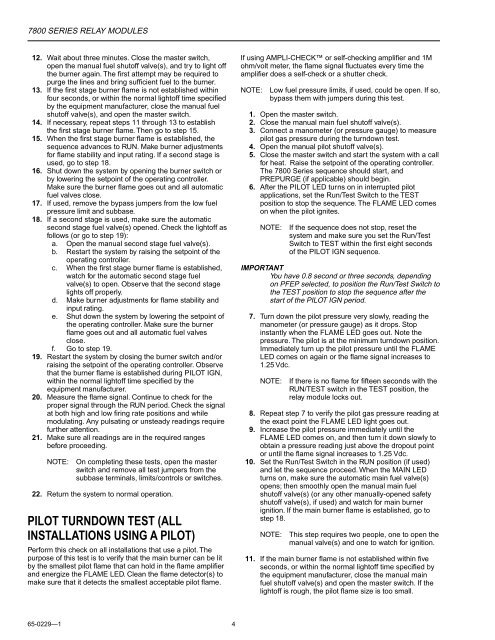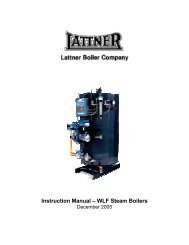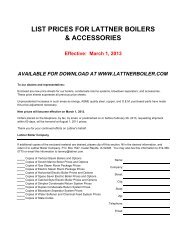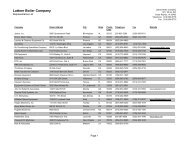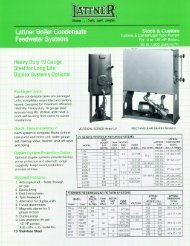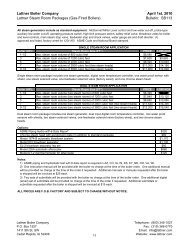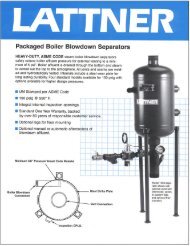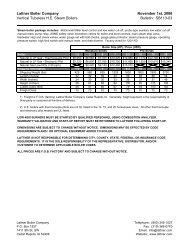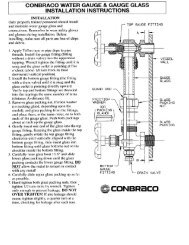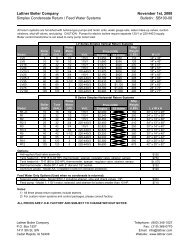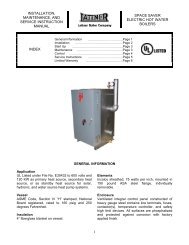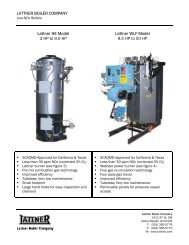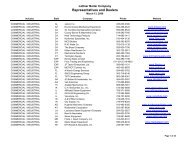65-0229 - 7800 SERIES Relay Modules - Greenheck
65-0229 - 7800 SERIES Relay Modules - Greenheck
65-0229 - 7800 SERIES Relay Modules - Greenheck
Create successful ePaper yourself
Turn your PDF publications into a flip-book with our unique Google optimized e-Paper software.
<strong>7800</strong> <strong>SERIES</strong> RELAY MODULES<br />
12. Wait about three minutes. Close the master switch,<br />
open the manual fuel shutoff valve(s), and try to light off<br />
the burner again. The first attempt may be required to<br />
purge the lines and bring sufficient fuel to the burner.<br />
13. If the first stage burner flame is not established within<br />
four seconds, or within the normal lightoff time specified<br />
by the equipment manufacturer, close the manual fuel<br />
shutoff valve(s), and open the master switch.<br />
14. If necessary, repeat steps 11 through 13 to establish<br />
the first stage burner flame. Then go to step 15.<br />
15. When the first stage burner flame is established, the<br />
sequence advances to RUN. Make burner adjustments<br />
for flame stability and input rating. If a second stage is<br />
used, go to step 18.<br />
16. Shut down the system by opening the burner switch or<br />
by lowering the setpoint of the operating controller.<br />
Make sure the burner flame goes out and all automatic<br />
fuel valves close.<br />
17. If used, remove the bypass jumpers from the low fuel<br />
pressure limit and subbase.<br />
18. If a second stage is used, make sure the automatic<br />
second stage fuel valve(s) opened. Check the lightoff as<br />
follows (or go to step 19):<br />
a. Open the manual second stage fuel valve(s).<br />
b. Restart the system by raising the setpoint of the<br />
operating controller.<br />
c. When the first stage burner flame is established,<br />
watch for the automatic second stage fuel<br />
valve(s) to open. Observe that the second stage<br />
lights off properly.<br />
d. Make burner adjustments for flame stability and<br />
input rating.<br />
e. Shut down the system by lowering the setpoint of<br />
the operating controller. Make sure the burner<br />
flame goes out and all automatic fuel valves<br />
close.<br />
f. Go to step 19.<br />
19. Restart the system by closing the burner switch and/or<br />
raising the setpoint of the operating controller. Observe<br />
that the burner flame is established during PILOT IGN,<br />
within the normal lightoff time specified by the<br />
equipment manufacturer.<br />
20. Measure the flame signal. Continue to check for the<br />
proper signal through the RUN period. Check the signal<br />
at both high and low firing rate positions and while<br />
modulating. Any pulsating or unsteady readings require<br />
further attention.<br />
21. Make sure all readings are in the required ranges<br />
before proceeding.<br />
<strong>65</strong>-<strong>0229</strong>—1<br />
NOTE: On completing these tests, open the master<br />
switch and remove all test jumpers from the<br />
subbase terminals, limits/controls or switches.<br />
22. Return the system to normal operation.<br />
PILOT TURNDOWN TEST (ALL<br />
INSTALLATIONS USING A PILOT)<br />
Perform this check on all installations that use a pilot. The<br />
purpose of this test is to verify that the main burner can be lit<br />
by the smallest pilot flame that can hold in the flame amplifier<br />
and energize the FLAME LED. Clean the flame detector(s) to<br />
make sure that it detects the smallest acceptable pilot flame.<br />
4<br />
If using AMPLI-CHECK or self-checking amplifier and 1M<br />
ohm/volt meter, the flame signal fluctuates every time the<br />
amplifier does a self-check or a shutter check.<br />
NOTE: Low fuel pressure limits, if used, could be open. If so,<br />
bypass them with jumpers during this test.<br />
1. Open the master switch.<br />
2. Close the manual main fuel shutoff valve(s).<br />
3. Connect a manometer (or pressure gauge) to measure<br />
pilot gas pressure during the turndown test.<br />
4. Open the manual pilot shutoff valve(s).<br />
5. Close the master switch and start the system with a call<br />
for heat. Raise the setpoint of the operating controller.<br />
The <strong>7800</strong> Series sequence should start, and<br />
PREPURGE (if applicable) should begin.<br />
6. After the PILOT LED turns on in interrupted pilot<br />
applications, set the Run/Test Switch to the TEST<br />
position to stop the sequence. The FLAME LED comes<br />
on when the pilot ignites.<br />
NOTE: If the sequence does not stop, reset the<br />
system and make sure you set the Run/Test<br />
Switch to TEST within the first eight seconds<br />
of the PILOT IGN sequence.<br />
IMPORTANT<br />
You have 0.8 second or three seconds, depending<br />
on PFEP selected, to position the Run/Test Switch to<br />
the TEST position to stop the sequence after the<br />
start of the PILOT IGN period.<br />
7. Turn down the pilot pressure very slowly, reading the<br />
manometer (or pressure gauge) as it drops. Stop<br />
instantly when the FLAME LED goes out. Note the<br />
pressure. The pilot is at the minimum turndown position.<br />
Immediately turn up the pilot pressure until the FLAME<br />
LED comes on again or the flame signal increases to<br />
1.25 Vdc.<br />
NOTE: If there is no flame for fifteen seconds with the<br />
RUN/TEST switch in the TEST position, the<br />
relay module locks out.<br />
8. Repeat step 7 to verify the pilot gas pressure reading at<br />
the exact point the FLAME LED light goes out.<br />
9. Increase the pilot pressure immediately until the<br />
FLAME LED comes on, and then turn it down slowly to<br />
obtain a pressure reading just above the dropout point<br />
or until the flame signal increases to 1.25 Vdc.<br />
10. Set the Run/Test Switch in the RUN position (if used)<br />
and let the sequence proceed. When the MAIN LED<br />
turns on, make sure the automatic main fuel valve(s)<br />
opens; then smoothly open the manual main fuel<br />
shutoff valve(s) (or any other manually-opened safety<br />
shutoff valve(s), if used) and watch for main burner<br />
ignition. If the main burner flame is established, go to<br />
step 18.<br />
NOTE: This step requires two people, one to open the<br />
manual valve(s) and one to watch for ignition.<br />
11. If the main burner flame is not established within five<br />
seconds, or within the normal lightoff time specified by<br />
the equipment manufacturer, close the manual main<br />
fuel shutoff valve(s) and open the master switch. If the<br />
lightoff is rough, the pilot flame size is too small.


